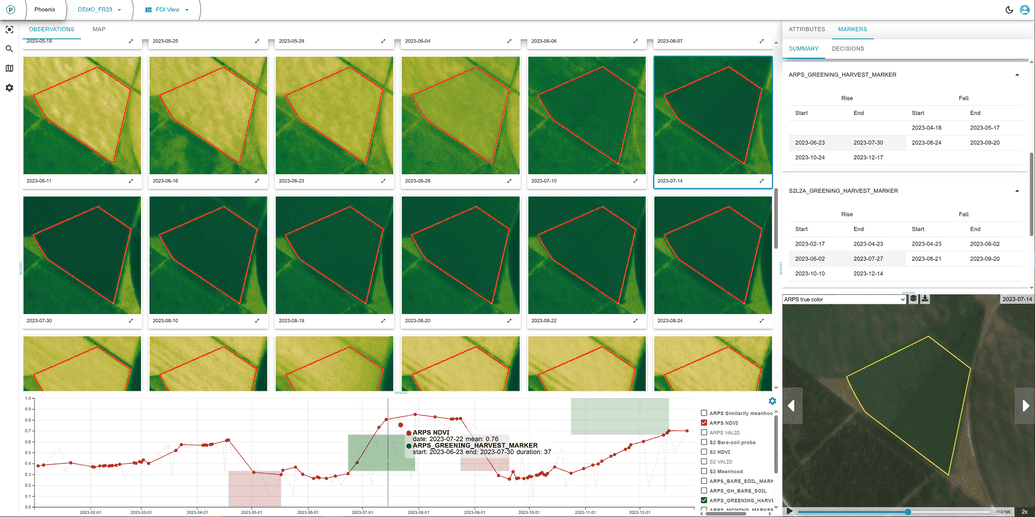Greening and Harvest Marker
Basic info
The greening and harvest marker identifies greening and harvest phases in the FOI's NDVI time series and combines them into a single period that signifies the life cycle of a crop. It can be a very useful tool for detecting presence of catch crops or green cover and nitrogen-fixing crops, i.e the management practices under the EFA obligation of which main objective it to safeguard and improve biodiversity on farms. The greening and harvest marker can give answers to the following questions:
- When was the main crop sown and when harvested?
- After the harvest of the main crop, when did the second crop start developing?
- Until when was the second crop present on the field, i.e. when was it harvested?
If greening and harvest marker is fused with bare-soil marker results, then the combined results can provide answers to questions like:
- How was the soil prepared before sowing of the main crop - was the field ploughed or not?
- Was the second crop established with undersowing?
- Before sowing of the second crop, was the field ploughed or did the farmer use some light cultivation techniques? Was the stubble left in the field after the harvest of the main crop?
The greening phase starts when the crop emerges from the soil (NDVI value is low) and ends when it fully matures (NDVI will reach a plateau). In between, NDVI values will steadily increase. When crop is harvested, plants are partially or entirely removed from the field. This activity is reflected in a sudden drop of NDVI value, often (but not necessarily) followed by a period when bare soil is detected. Harvest phase typically doesn't last long. Its detection is triggered by an abrupt and significant drop of the NDVI value.
The greening and harvest marker output can be visually presented with a plot, e.g. like below for FOI, where we observe 2 greening periods and one harvest period in between.
The greening and harvest marker is a means to identify changes in the NDVI time series that indicate agricultural activity on a FOI. The greening/harvest phase reflects the duration of the change in the NDVI time series and therefore the period within which we expect the activity to have taken place.
- Light green strip corresponds to an extended greening phase, dark green strip to the "actual" greening phase.
- Similarly, light red strip corresponds to an extended harvest phase and dark red strip to the "actual" harvest phase. The distinction between the extended and "actual" phase becomes important when we condition the eligibility with e.g. start of the greening phase or harvesting of the crop within a required or forbidden period. If we take a look at the harvest period and imagine a potential rule that the main crop should not be harvested before June 15th: the "actual" harvest period starts when we, for the first time, notice the consequence of the harvest, i.e. a significant drop of the NDVI value, and this happened after June 15th. If we were validating the eligibility based on the start of the extended harvest phase, FOI would be found harvested before the June 15th and therefore ineligible.
- Observation marks enclosed in red diamonds indicate when bare soil was detected. We can, for example, mathematically describe a requirement for presence of baresoil observations before the greening or after the harvest phase, within a specified number of days. For undersown crops, the bare-soil before the greening phase is not required. However, for some practices, e.g. for non-winter crops sown after the main crop, bare-soil might be mandatory.
- Black arrow indicates the total duration of one greening-harvest cycle.
The changes in vegetation cover are best visible in the Sentinel-2 False colour time series visualisation. In the image below, the green stripe on top of the imagettes marks the greening phase, where we can observe the intensifying of the red colour within the FOI's boundary, indicating vegetation growth. After the vegetation reaches full maturity (and the NDVI value plateaus), we can observe the beginning of the harvest phase (marked with the yellow strip) as the intensity of the red false colour starts fading towards a more brownish colour, indicating the underlying soil, exposed after the vegetation removal. We can also see that towards the end of the harvest period, there are observations of exposed bare soil (marked with the brown icon). After harvest, we observe a new greening phase as the vegetation picks up again in late summer/early autumn.
Marker output
In the Area Monitoring App, the greening and harvest periods are marked with reddish stripes in the Signals Markers Visualization component at the bottom. The green stripe marks the greening phase and the red one indicates the harvest phase.
See example FOI = 92273921
Further info
For a detailed description of the greening and harvest marker output, check the Marker Service API documentation.


